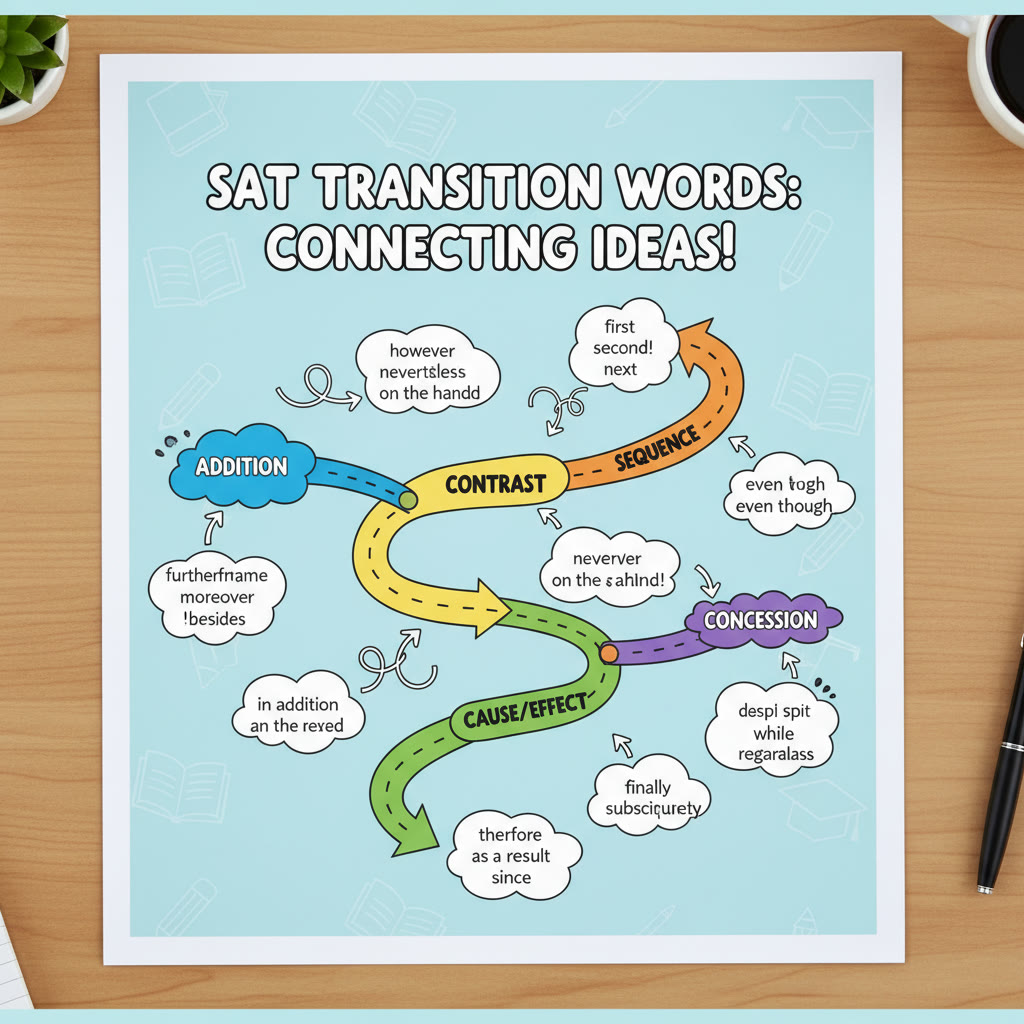Why Transitional Phrases Matter on the SAT
When you sit down for the SAT Writing and Language section, the questions often feel like tiny editing puzzles. You zoom in on commas, verbs, and pronouns — and sometimes you miss the thread that ties sentences and ideas together. That’s where transitional phrases come in. They are the invisible stitches that hold an argument or explanation together. A well-placed transition makes relationships between ideas clear, improves flow, and often turns a shaky sentence into a correct one.
On the SAT, the test makers want to see that you can craft coherent, logically connected writing. Even a grammatically correct sentence can be wrong in context if the transition misrepresents the relationship between clauses. Recognizing and choosing the right transitional phrase is a high-leverage skill: it improves accuracy on many questions and helps in the optional essay and any time you’re asked to improve paragraph coherence.
A quick, human example
Imagine you tell a friend: “I studied hard; however, I failed the test.” The transition ‘however’ signals contrast. Swap it to ‘therefore’ and the meaning breaks: “I studied hard; therefore, I failed the test.” Now the cause-effect relationship doesn’t make sense. The SAT tests this sort of distinction all the time. Understanding the purpose of each transition will save you from choosing something that sounds okay but is logically wrong.
Types of Transitional Phrases and When to Use Them
Not all transitions are equal. Some show contrast, others show addition, cause and effect, sequence, or emphasis. Below is a practical breakdown you can memorize and use as a mental checklist while you work through questions.
| Category | Function | Common Examples |
|---|---|---|
| Addition | Join similar ideas or add information | and, furthermore, moreover, in addition, also |
| Contrast | Show difference or opposing idea | however, although, nevertheless, on the other hand |
| Cause/Effect | Show reason or result | therefore, consequently, because, thus, as a result |
| Sequence/Time | Order events or steps | first, next, then, subsequently, finally |
| Concession | Acknowledge opposing point then qualify | although, even though, while, granted, despite |
| Illustration/Emphasis | Highlight, clarify, or give an example | for example, in fact, indeed, specifically |
How the SAT tests these categories
Most transition questions present a sentence or pair of sentences and ask which choice best connects them or whether a transition should be inserted at all. The key is to ask: what is the logical relationship the author intends? Pick the category first (contrast? addition? cause/effect?), then the precise word that matches that relationship. This two-step approach avoids being misled by words that are grammatically fine but logically off.
Spotting the Relationship: Read for Logic, Not Just Grammar
When a question asks you to choose a transition, do this short mental checklist before scanning choices:
- Identify the two ideas being connected. Are they opposing? Sequential? One explains the other?
- Decide the author’s intended stance: agreement, contrast, reason, or concession.
- Match the category to transition choices, then read the sentence aloud to feel whether the meaning is logical.
Reading aloud or silently emphasizing the logical link (“this happened, therefore that happened”) often reveals a mismatch. Practice makes this habit automatic: the SAT rewards quick, consistent logic checks.
Example: A small but revealing SAT-style item
Original (with choice blanks): “The city introduced a composting program; ____ residents now recycle food waste more effectively.”
- If the intended meaning is cause-and-effect (the program led to better recycling), choose “as a result” or “consequently.”
- If the sentence wanted to add information, you might use “in addition,” but that would be weaker when cause is intended.
- If contrast were intended, the word would be something like “however,” which would make no sense in our example.
So the best fit: “The city introduced a composting program; as a result, residents now recycle food waste more effectively.” The logic is clear; the transition mirrors it.
Common Pitfalls and How to Avoid Them
Even strong writers stumble on transitions. Here are recurring traps students face on the SAT and practical ways to avoid them.
1. Choosing a grammatically correct but logically wrong transition
Many errors on SAT Writing are not about grammar alone but about logic. “Moreover” and “however” can both be grammatically correct depending on punctuation and sentence structure, yet they signal opposite relationships. Always ask: does this word represent agreement or contrast?
2. Ignoring the sentence before or after the blank
Sometimes students focus only on the sentence with the blank and ignore the surrounding context. Transitions often connect across sentences or clauses. Read the sentence that comes before and after to capture the full logical chain.
3. Overusing simple transitions in your own writing
In essays and practice, “however” and “therefore” become filler when students are unsure. Vary your transitions for clarity and style. The SAT doesn’t penalize variety, but your own writing will feel more confident and polished if transitions are precise.
4. Confusing concession with contrast
Concession words like “although” or “even though” acknowledge an opposing point but usually lead to a qualification. Contrast words like “however” often simply set two opposing facts side by side. The subtle difference matters: “Although” sets up a concession that will be resolved or limited in the main clause.
Practical Strategies and Shortcuts
Here are concrete habits to adopt during practice and on test day that will make transition choices faster and more accurate.
- Always read at least one sentence before and after the blank. If a question gives a paragraph, scan the whole paragraph for the author’s tone and logical flow.
- Label the relationship in one word: contrast, cause, addition, sequence, concession, example. Then eliminate choices that don’t match that label.
- Beware of extreme language. Words like “always,” “never,” or unequivocal cause-effect connectors may be wrong if the context is more nuanced.
- Practice sorting transition words into categories until you can do it without thinking. Make flashcards or a quick chart (see table above) you can reference while studying.
Timed practice tip
During timed sections, use 10–15 seconds to identify the logical link, then pick a transition. If you’re unsure after reading choices, mark the question and finish the section; return later with fresh perspective. Many students find that transitions suddenly click on a second pass because the paragraph context becomes clearer.
Worked Examples: Before-and-After Edits
Seeing how a single word changes meaning will sharpen your instincts. Below are SAT-style before-and-after edits with explanations.
Example 1 — Contrast vs. Addition
Original: “The experiment showed promising results; ____ the researchers cautioned that more trials were needed.”
- Options: “therefore,” “however,” “in addition”
- “Therefore” implies the caution is a result of the promising results — that doesn’t fit. “In addition” would awkwardly stack two facts without clarifying their relationship. “However” correctly signals that the researchers’ caution contrasts with the promise of the results.
Correct: “The experiment showed promising results; however, the researchers cautioned that more trials were needed.”
Explanation
Contrast is intended: good results exist, but they don’t eliminate the need for caution. “However” captures that opposition cleanly.
Example 2 — Cause and Effect
Original: “Traffic congestion increased during the festival, ____ local businesses reported higher sales than usual.”
- Options: “therefore,” “consequently,” “nevertheless,” “meanwhile.”
- If congestion increased because more people came for the festival and businesses saw higher sales, the connection is simultaneous or co-occurring, so “meanwhile” works best. If the sentence intended to say congestion caused higher sales (which sounds unlikely) then a cause/effect connector would be wrong.
Correct: “Traffic congestion increased during the festival; meanwhile, local businesses reported higher sales than usual.”
Explanation
The relationship is temporal and correlational, not causal. “Meanwhile” signals two things happening at the same time, which is the most logical reading.
Editing for Economy: When No Transition Is Better
Sometimes the best choice is to remove a transition or choose a punctuation-only solution. The SAT occasionally offers options like “no change” for a blank. If the sentences already flow logically and the transition adds redundancy or clumsiness, “no change” or a punctuation adjustment might be the correct answer.
Example: “She loves hiking, and she spends every weekend exploring trails.” Insert a transition between these clauses? Not necessary — the coordinating conjunction ‘and’ already provides the connection. On the SAT, avoid overcomplicating: simpler, clearer is often correct.
Practice Drills to Build Mastery
Consistency beats cramming. Here are structured drills you can use for daily practice. Commit to short, focused sessions and mix in full passages occasionally so you see transitions in larger contexts.
- Flashcard drill: One side has a transition word, the other has its category and a short definition. Shuffle and sort into piles by category until you can do it quickly.
- Sentence editing: Take 10 sentences and replace the transition with a blank. Try to fill the blank with three different categories and decide which fits best, explaining why.
- Timed section practice: Do 15–20 Writing and Language questions, focusing only on transition-type questions. Track accuracy and review errors carefully.
- Paragraph coherence practice: Rewrite paragraphs to improve flow using a variety of transitions. Aim for clarity and economy — remove any redundant connectors.
Using tutoring to accelerate improvement
If you want faster, targeted gains, a tutor can create a personalized plan focused on transition logic and common error patterns. Sparkl’s personalized tutoring offers 1-on-1 guidance, tailored study plans, expert tutors, and AI-driven insights to help you identify which transition types trip you up and build strategies to correct them. The combination of human feedback and data-driven practice can make your study time much more efficient.
Common Transition Words: A Handy Reference
Memorize and practice with this short list of transition words grouped by function. You don’t need to use every word — know the nuance of a few strong choices in each category.
| Function | Words to Know |
|---|---|
| Addition | and, additionally, moreover, furthermore, in addition |
| Contrast | but, however, nevertheless, on the other hand, in contrast |
| Cause/Effect | because, therefore, consequently, thus, as a result |
| Sequence/Time | first, next, then, subsequently, meanwhile, finally |
| Concession | although, even though, while, granted, despite |
| Illustration/Emphasis | for example, for instance, in fact, in particular, indeed |
How to Review Mistakes Effectively
Quality review beats quantity. After practice sets, don’t just mark a question wrong — interrogate it.
- Write down the intended relationship in one sentence (“This is a contrast between X and Y”) and explain why your chosen transition did or didn’t match it.
- If you guessed, categorize the reason for guessing: time pressure, vocabulary uncertainty, or misreading context. That helps you fix the specific weakness.
- Recreate similar sentences that target the same logical relationship and practice them until you feel consistent.
Transitional Phrases Beyond the Test: Clear Communication Skills
Learning transitions isn’t just test prep. Whether you’re writing college essays, lab reports, or an email, the ability to signal relationships between ideas is invaluable. Strong transitions make your writing persuasive and easier to follow. Practicing transitions for the SAT gives you a transferable skill that will serve you in classes and professional contexts.
A real-world analogy
Think of transitions as the traffic signals of your writing. Without them, readers hesitate at junctions, unsure whether to stop, go, or turn. With clear signals — the right transition words — flow is smooth, meaning is preserved, and readers arrive at your point without confusion.


Putting It All Together: A Day-By-Day Mini-Plan
If you have a week to focus on transitions, here’s a simple plan you can follow. Short, consistent practice is more effective than marathon studying.
- Day 1 — Foundation: Learn and categorize 20 common transition words. Make flashcards.
- Day 2 — Application: Do 30 transition-type SAT questions. Review each mistake thoroughly.
- Day 3 — Production: Rewrite five paragraphs from practice passages to improve flow and clarity.
- Day 4 — Timed practice: Complete a timed Writing and Language section, focusing on quick logic checks.
- Day 5 — Targeted review: Work with a tutor or study partner to go over persistent errors. If you use Sparkl’s personalized tutoring, this is a great time to get specific feedback and a tailored plan based on your error patterns.
- Day 6 — Mixed practice: Combine reading passages and transition questions. Simulate test conditions for one section.
- Day 7 — Reflection: Analyze progress, identify three transitions you still find tricky, and plan review sessions for the next week.
Final Thoughts: Small Words, Big Difference
Transitional phrases may be short, but their impact is outsized. On the SAT Writing and Language section, they are the deciding detail between a clear, correct answer and a subtly wrong one. The good news is that they are learnable: with categorized practice, attentive reading, and targeted review you can build a reliable intuition for which transition belongs where. If you pair disciplined practice with personalized guidance — whether it’s a skilled tutor or Sparkl’s blend of expert tutors and AI-driven insights — you’ll reach that fluency faster and with more confidence.
Remember: focus on logic before vocabulary, read surrounding context, and practice deliberately. Over time, transitions will stop being a chore and become a natural part of the way you think about and craft sentences. And that clarity will show up not only in your SAT score but in everything you write afterward.
Good luck — keep connecting the dots.















No Comments
Leave a comment Cancel